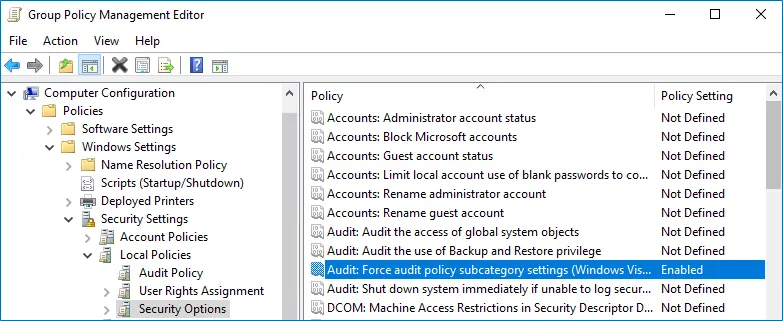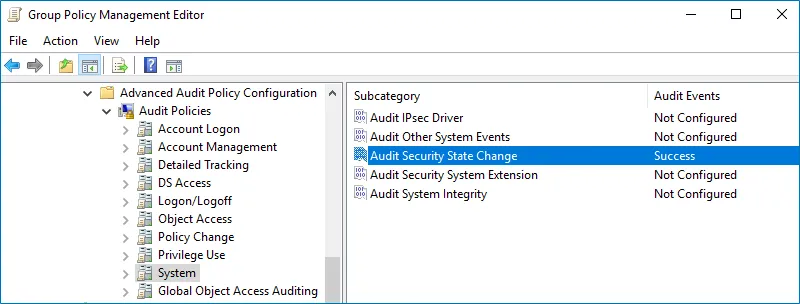Configure Advanced Audit Policies
You can configure advanced audit policies instead of basic domain policies to collect Logon Activity changes with more granularity.
Follow the steps to configure security options.
Using both basic and advanced audit policies settings may lead to incorrect audit reporting. To force basic audit policies to be ignored and prevent conflicts, enable the Audit: Force audit policy subcategory settings to override audit policy category settings option.
Step 1 – Open the Group Policy Management console on any domain controller in the target domain: navigate to Start > Windows Administrative Tools> Group Policy Management.
Step 2 – In the left pane, navigate to Forest: <forest_name> > Domains > <domain_name> >
Domain Controllers. Right-click the effective domain controllers policy (by default, it is the
Default Domain Controllers Policy), and select Edit from the pop-up menu.
Step 3 – In the Group Policy Management Editor dialog, expand the Computer Configuration node on the left and navigate to Policies > Windows Settings > Security Settings > Local Policies > Security Options.
Step 4 – Locate the Audit: Force audit policy subcategory settings to override audit policy category settings and make sure that policy setting is set to "Enabled".

Step 5 – Navigate to Start > Run and type "cmd". Input the gpupdate /force command
and press Enter. The group policy will be updated.
Follow the steps to configure advanced audit policies.
Step 6 – Open the Group Policy Management console on any domain controller in the target domain: navigate to Start > Windows Administrative Tools> Group Policy Management.
Step 7 – In the left pane, navigate to Forest: <forest_name> > Domains >
<domain_name> > Domain Controllers. Right-click the effective domain controllers policy
(by default, it is the Default Domain Controllers Policy), and select Edit from the pop-up
menu.
Step 8 – In the Group Policy Management Editor dialog, expand the Computer Configuration node on the left and navigate to Policies > Windows Settings > Security Settings > Advanced Audit Policy Configuration > Audit Policies .
Step 9 – Configure the following audit policies.
| Policy Subnode | Policy Name | Audit Events |
|---|---|---|
Account Logon
|
| "Success" and "Failure" |
| "Success" and "Failure" | |
Logon/Logoff |
| "Success" |
| "Success" and "Failure" | |
System |
| "Success" |

Step 10 – Set the following advanced audit policies to "Success" and "Failure":
- Audit Kerberos Service Ticket Operations
- Audit Kerberos Authentication Service
- Audit Credential Validation
Step 11 – Set the Audit Security State Change advanced audit policy to "Success".
Step 12 – Navigate to Start > Run and type "cmd". Input the gpupdate /force command
and press Enter. The group policy will be updated.